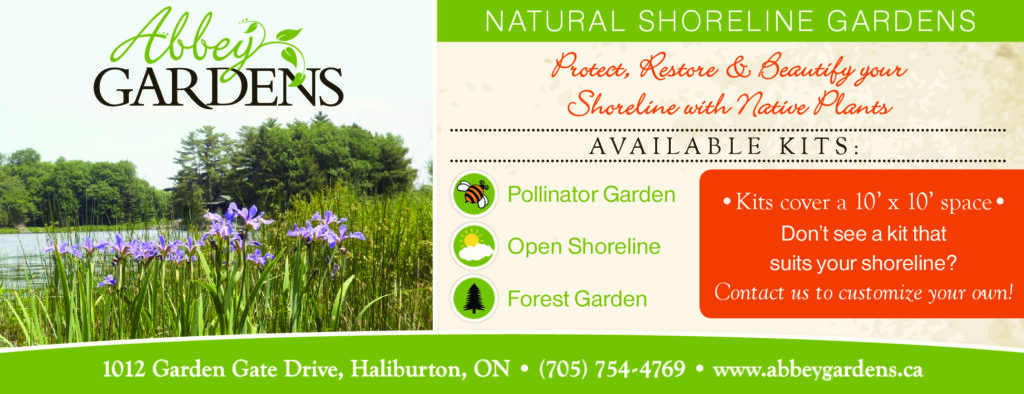Natural shorelines are vital to maintaining the overall health of a lake. Increasingly, shorelines along lakes and rivers are being developed, which leaves these areas at greater risk of erosion, flooding, poor water quality, algae blooms, and excessive weed growth. Naturalizing shorelines by planting native flowers, trees, and shrubs helps keep our Haliburton County lakes swimmable, drinkable, and fishable.
Not convinced a natural shoreline is the way to go? Here are four reasons why you should naturalize your shoreline:
1. Biodiversity
Did you know that shorelines are called the Ribbon of Life? Roughly 70% of land species and 90% of aquatic species depend on healthy shoreline habitat for nesting, shelter, travel, reproduction and feeding. Logs, branches, debris, rocks, and plants are all critical to fish and wildlife. Vegetated natural shorelines create nursery habitats for fish. Healthy shorelines = great fishing!
2. Water Quality
Water run-off from streets, rooftops, and other hard surfaces contain pollutants, sediment, and other contaminants that end up in our lakes, rivers, and streams. Natural shoreline plants slow down the runoff, allowing time for contaminated water to infiltrate the soil and get absorbed by plant roots before entering the lake. Plant roots also capture some forms of nutrients, like phosphorus and nitrogen, which contribute to algae blooms.
3. Erosion
Plants with deep root systems hold soil together and mitigate the effects of wave, ice, and wind activity to help prevent erosion. Eroding shorelines literally eat away at your lakefront property.
4. Property Value
One algae bloom can lower property value by 30% (estimate by Canadian Real Estate Association). Swimming, fishing, and drinking lake water is prohibited during algal blooms and greatly diminishes the desirability of the lake.

How can you naturalize your shoreline?
There are a variety of design possibilities and plant combinations to choose from for your natural shoreline based on the conditions at your individual site. How many hours of sunlight does your site get? Is the soil wet, dry, or somewhat in between? What are the uses for your property? Do you want to maintain your sight line to the water, or would you like to create privacy? All these factors play a significant role when choosing the right naturalization method and timeline for you. Some possibilities include:
- Indirectly restore your shoreline by creating a no-mow buffer along your shoreline. Over time, suitable plants will fill in the buffer zone.
- Directly restore your shoreline by planting trees, shrubs, and wildflowers along your shoreline.
- Remove hardscaped materials (retaining walls, gabion baskets etc.) or soften them with plants.
Let us help you!
At Abbey Gardens in Haliburton, we have created shoreline plant kits that represent site conditions common to our area. Pollinator Garden Kits are for sites with dry to normal soil that experience part shade to full sun. This kit includes a mix of wildflowers, grasses, shrubs, and trees that will attract pollinators throughout the whole season. Open Shoreline kits benefit sites with low lying areas that have moist soil and at least 6 hours of sunlight per day. Wildflowers can be planted right at the waters’ edge to create a beautiful display of colour. Forest Garden kits are appropriate for shaded shorelines that have dry to normal soil. Alternatively, the plants can be used to naturalize and add plant diversity to shady upland areas. Shoreline kits can be ordered through our online store and picked up at the Food Hub.
If your site conditions differ from the ones listed, or you would like to create a garden in shallow bedrock soils, moist & shady areas, meadows or over your septic bed, we can customize your plant order to suit your needs.

